 Image search results - "Mie" Image search results - "Mie" |
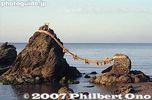
Meoto-Iwa Wedded Rocks off the coast of Futami-cho, Ise city, Mie Prefecture. 夫婦岩
|
|

The Wedded Rocks are part of Futami Okitama Shrine known for frog sculptures. 二見興玉神社
|
|
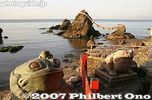
The shrine is dedicated to Sarutahiko and Ukano-mitama. Sarutahiko is a god which serves as a pathfinder guide. Deities for land/sea transportation safety. 二見�
|
|

The frog is Sarutahiko's messenger. Frog is called "kaeru" in Japanese, which is a homonym for the another word meaning "return home." If you travel a lot, pray here for a safe return. 夫婦岩
|
|
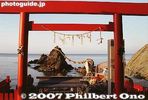
Futami Okitama Shrine does not have a main hall (Honden) like most other shrines. It worships the Okitama Sacred Stone in the ocean beyond the Wedded Rocks. 二見興玉神社
|
|
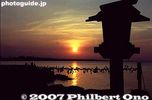
Lantern and sunset at Futami Okitama Shrine
|
|

Sunset at Futami Okitama Shrine. In the old days when traveling was a hazardous undertaking in Japan, pilgrims who traveled to worship at the Ise Grand Shrines prayed here for a safe return home.
|
|

The shimenawa rope bonding the Wedded Rocks is replaced three times a year. May 5, when these photos were taken, is one of the days when they replace the rope. First, they gathered at the shrine at 10 am for a 30-min. prayer ceremony.
|
|
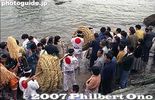
Men carry spanking-new shimenawa ropes to the rocks.
|
|
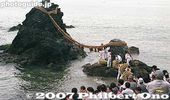
The Wedded Rocks are actually a type of torii gate for worshipping the Okitama Sacred Stone in the ocean.
|
|

The torii on the larger rock is quite small. The sacred rope is replaced three times a year on May 5, September 5, and at the end of December.
|
|
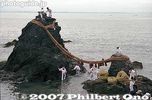
5月5日、9月5日と12月下旬には夫婦岩の大注連縄の張り替え神事が行われる。これらの写真は5月5日に撮影された。
|
|
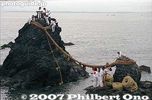
The men begin to cut off the old rope. Those sharp sickles soon made short work of the old sacred ropes which were brought ashore in small pieces.
|
|
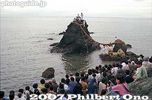
The ceremony attracts a large crowd.
|
|

The shimenawa rope actually consists of five smaller ropes. They cut the ropes one by one.
|
|

The ropes are now completely cut, breaking the bond between the two rocks.
|
|
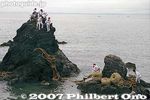
The old rope is taken away.
|
|
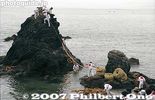
The new ropes are strung across the two rocks. A small rope tied to the end of the large rope is used to pull the large rope up the rock.
|
|
|

The first rope is wound around both rocks.
|
|

The second rope is installed.
|
|
|

One by one, the men carefully positioned the new sacred ropes on the two Rocks. All the while, young children and young men are chanting on the shore.
|
|
|
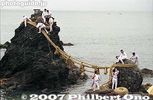
Replacing the rope for the Wedded Rocks, Mie Pref.
|
|

Five ropes are being positioned and made taut.
|
|
|

All the while, the cheering section chants and wave streamers.
|
|
|
|
|
|

Pieces of the old rope. Anyone could take home the pieces of old sacred rope if they wanted.
|
|

Making sure that the rope is aligned and positioned correctly.
|
|
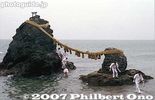
The job is finished.
|
|

The rope installers return to shore.
|
|
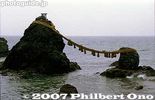
Wedded Rocks with a new rope. Japan has numerous other Wedded Rocks and stones, but this is by far the most famous.
|
|

Iga-Ueno Castle is one of three major tourist attractions in the city of Iga. It is a short walk from Ueno-shi Station on the Kintetsu Iga Line.
|
|

Stone marker for Ueno Castle located in Ueno Park. Officially called Ueno Castle and nicknamed Hakuho Castle or Iga-Ueno Castle. Noted for cherry blossoms in April and the highest castle walls in Japan.
|
|

Iga-Ueno Castle was first built by Takigawa Katsutoshi, a vassal of Kitabatake Nobuaki (Oda Nobuo, Nobunaga's second son). In 1585, Tsutsui Sadatsugu took over. initiated construction of Iga Ueno Castle in 1585. He was followed by Tsutsui Sadatsugu
|
|

They are still excavating a few areas of the castle for historical remains. I visited in April 2009.
|
|

In 1611, Todo Takatora took over Ueno Castle. Iga-Ueno Castle is also a major cherry blossom spot in early April.
|
|

Iga-Ueno Castle and cherry blossoms, Mie Prefecture.
|
|

Iga-Ueno Castle and cherry blossoms, Mie Prefecture.
|
|
|

Iga-Ueno Castle and cherry blossoms, Mie Prefecture. During the Meiji Restoration, Ueno Castle's structures were dismantled as with many other castles.
|
|

Iga-Ueno Castle's donjon or tenshu tower was reconstructed in 1935 by Kawasaki Katsu, a local politician, using his own funds.
|
|

Iga-Ueno Castle and cherry blossoms, Mie Prefecture.
|
|

In 1980, Ueno Castle served as a backdrop for Kurosawa Akira's movie, Kagemusha.
|
|
|
|
|
|
|
|
|
|
|
|

Inside the castle tower is the Iga Museum of Culture and Industry. This is the first floor.
|
|
|
|
|

Todo Takatora was originally from Omi or neighboring Shiga Prefecture.
|
|

Todo Takatora's helmet
|
|

Samurai armor
|
|

Bust of Kawasaki Katsu.
|
|

Top floor
|
|
|

View from atop Iga-Ueno Castle.
|
|

View from atop Iga-Ueno Castle, looking toward Ueno-shi Station.
|
|
|
|
|

Park area above the castle wall.
|
|

You could jump off into the moat below. No fences, so watch your kids.
|
|

Edge of castle wall.
|
|

One of the tallest castle walls in Japan.
|
|
|
|
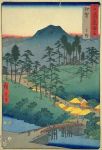
Hiroshige's woodblock print of Iga-Ueno from his "Famous Views of the 60 Provinces" series. The castle can be seen in the distance.
|
|

Iga Ueno Danjiri Museum
|
|

Inside Iga Ueno Danjiri Museum.
|
|
|
|
|

Ueno-shi Station
|
|

Ueno-shi Station has ninja dolls to greet you.
|
|

Even the trains have a ninja (female) paint job.
|
|

Ninja paint job on a train.
|
|

Iga-Ueno really plays up its ninja past.
|
|

Iga-ryu Ninja House is in Ueno Park which includes Iga-Ueno Castle nearby.
|
|

Iga-ryu Ninja House is a thatched-roof house whose roof once caught fire in the 1990s. It was rebuilt.
|
|

Iga-ryu Ninja House garden. They take you in groups, so you may have to wait a while before you can go in.
|
|

Once a group gets large enough, they take you all in and a female ninja guide explains the house's ninja trickery. Admission charged. Recommended is the set of tickets that admit you to the ninja house, castle, and Danjiri Museum.
|
|

The first demo is this swinging wall.
|
|

Lets you escape to the next room instantly, or climb up or down the ladder on the right wall.
|
|

This is a staircase concealed as a shelf.
|
|

Now a shelf. It leads to the attic.
|
|

Another wall door that leads to the basement tunnel.
|
|

Entrance to the basement.
|
|

Another swinging wall door.
|
|

Inside the Iga-ryu Ninja House.
|
|

Emergency escape hatch whose lock can be quickly released with a sheet of paper.
|
|

There she goes.
|
|

Hidden floor compartment where they hid their valuables outside the house.
|
|

When you push in the end of this floor plank, it opens up to reveal a sword.
|
|

Sword hidden in the floor.
|
|
|

Kunoichi female ninja guide
|
|

Inside the Iga-ryu Ninja House
|
|

An altar in the Iga-ryu Ninja House.
|
|
|
|
|

Kitchen area in Iga-ryu Ninja House.
|
|

Kitchen in Iga-ryu Ninja House.
|
|
|

Ninjas in the kitchen. We could not go up into the attic as we can in Koka's ninja house in Shiga.
|
|
|

Kitchen
|
|

Thatched-roof of Iga-ryu Ninja House.
|
|

Veranda of Iga-ryu Ninja House
|
|

Revolving door of Iga-ryu Ninja House
|
|

Iga-ryu Ninja Museum
|
|

Ninja disguises
|
|
|
|
|
|
|

Lock picks
|
|
|

Flipper-like clogs to walk through swamps
|
|
|

What would a ninja museum be without a display of shuriken?
|
|

Ninja swords are short and straight with no curvature.
|
|

For an extra 200 yen, you can watch the ninja show right next to the ninja house.
|
|

Iga-ryu Ninja House ninja show.
|
|

Sword demo
|
|
|
|

Shuruken takes skill to throw.
|
|
|
|

Juggling sickles. Having a sickle did not arouse suspicion as it was a common farming tool. But for the ninja, it was an effective weapon.
|
|

Throwing sickles and shuriken.
|
|
|

Duel to the death.
|
|

You have to applaud once in a while.
|
|

Shuriken throwing.
|
|

Nakayama Emiri, a TV personality, tries to throw shuriken.
|
|
|
|

Another ninja museum.
|
|

Inside ninja museum which is in a former rice warehouse.
|
|
|

Making medicine.
|
|

Ninja costumes
|
|

Five-colored rice grains used for secret communication.
|
|

Five-colored rice grains used for secret communication.
|
|

More secret ninja language.
|
|

Rope knots hung on roof eaves, etc., were also used for communication.
|
|
|
|

Ninja swords.
|
|

Iron claws
|
|

Bamboo sticks concealing a sword.
|
|

Pepper bombs to blind you.
|
|
|
|

Cushion
|
|

Iga-Ueno Ninja Festa poster
|
|

During April and early May, they hold the annual ninja festa.
|
|

See many people wearing ninja costumes during the ninja festa.
|
|

Where you can rent a ninja costume.
|
|

Ninjas under cherry blossoms.
|
|

Female ninja
|
|

Female ninja climbing over a wall.
|
|

Even ninja get thirsty.
|
|

Ninja shop
|
|

Ninja doll on a pole.
|
|

Everywhere you go in Iga-Ueno, you see a ninja motif.
|
|
|

Storefront shutter with ninja drawings.
|
|
|

Iga-Ueno's Ueno Park includes this beautiful building called the Haisei-den (俳聖殿), a hall dedicated to Haiku poet Matsuo Basho who was from Iga-Ueno.
|
|

A short walk from Iga-Ueno Castle and almost next to the ninja house, the Haisei-den was built in 1942 to mark the 300th anniversary of Basho's birth.
|
|

The building was designed by architect Ito Chota (1867-1954) (伊東 忠太) who designed numerous shrine and temple buildings in the 1920s and '30s, including Tsukiji Hongwanji temple in Tokyo.
|
|

The Haisei-den was designed to look like Basho in travel clothing. The top roof resembles a hat, and the lower roof resembles his straw raincoat. Cherry blossoms were in bloom.
|
|
|
|

Haisei-den and wisteria in bloom. The Basho Matsuri Festival is a poetry reading held here on Oct. 12.
|
|

Inside the Haisei-den is a ceramic statue of Basho.
|
|

Iga-yaki ceramic statue of Basho inside the Haisei-den.
|
|

A short walk from Ueno Park is the Basho Oseika (芭蕉翁生家) or Basho's childhood home. Iga is the birthplace of Matsuo Basho (1644-1694), and the house where he grew up in still stands.
|
|

The house is open to the public as a tourist attraction (admission 300 yen). The house was rebuilt after it being damaged by a large earthquake in 1854.
|
|

Room inside Basho's childhood home.
|
|
|

Small door to the kitchen. People must have been pretty short then.
|
|

Kitchen area with a well on the left and stoves toward the right.
|
|
|

Water well
|
|

Kitchen stoves
|
|
|

Toilets and bath
|
|

Urinal
|
|
|
|

The back of the house is Basho's study called Chogetsuken (釣月軒) where he wrote the Kai-ooi (貝おほい) series of poems.
|
|

Inside the Chogetsuken study. 釣月軒
|
|

The study is a very simple, yet aesthetic and meditative-looking room.
|
|
|
|

Statue of Basho at Ueno-shi Station.
|
|

Castle wall facing the streetWhen you walk to Tsu Castle from the bus stop, this is what you first see. It is obviously a flatland-type castle. Tsu Castle was first built in 1580 by Oda Nobukane, the younger brother of warlord Oda Nobunaga.
|
|

Castle wallThe stone wall is long, and the entrance to the castle grounds is on the far end, in front of the three-story Ushitora turret.
|
|

Three-story Ushitora turret, reconstructed in 1958.This is the only significant building remaining of the castle.
|
|

Ushitora turret
|
|
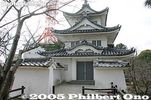
Ushitora turret entrance (not open)
|
|

Moat
|
|

Ushitora turret and stone wall
|
|

Moat
|
|

Inner stone wall
|
|

Statue of Lord Takatora Todo, who became the 11th lord of the castle in 1608. He is revered for revamping the castle and developing the castle town of Tsu. He was originally from Inugami, Shiga Pref. This statue was built in 1998.
|
|

Park fountain in the castle grounds
|
|

Tsu Castle, Ushitora turret
|
|

Foundation of the castle towerThe 5-story castle tower was destroyed in 1600 during the Battle of Sekigahara. It was never rebuilt.
|
|

Foundation of the castle tower (side view)
|
|

Foundation of the castle tower (rear)
|
|

Stone wall in the Honmaru
|
|

Garden in Nishinomaru
|
|

Nyutoku-mon Gate
|
|
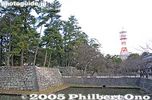
Moat
|
|
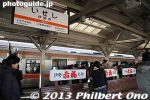
Ise-shi Station platform upon arrival on Jan. 1, 2013. Ise Jingu's Geku Outer Shrine is a short walk from this station.
|
|
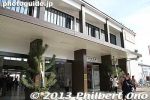
Ise-shi Station with kadomatsu New Year's decorations.
|
|
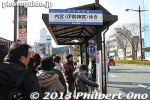
Bus stop for Naiku Inner Shrine. This is near Ise-shi Station.
|
|
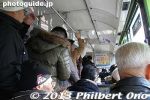
Inside the bus going to Naiku from Ise-shi Station.
|
|
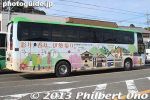
Colorful bus at Ise.
|
|
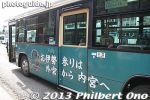
Bus with motif promoting Ise. Going to worship at Ise Jingu is called "Ise-mairi."
|
|
|

Map of Ise Jingu's Naiku Shrine. First you cross Uji Bridge.
|
|
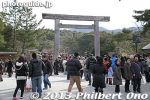
Torii gate at Uji Bridge. Very crowded with New Year's worshippers going for hatsumode prayers.
|
|
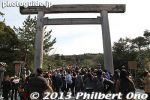
Ise Jingu Shrine's Naiku (Inner Shrine) is the main and most popular shrine at Ise. The shrine is rebuilt every 20 years and 2013 will mark the completion of the new shrine to replace the old one built in 1993.
|
|

Ise Jingu Shrine's Naiku is officially named, "Kotaijingu" (皇大神宮). It worships Amaterasu Omikami 天照坐皇大御神, the ancestor of the Imperial Family and the tutelary kami of the Japanese people. Naiku was founded 2000 years a
|
|

Crossing Uji Bridge, a little over 100 meters long. 宇治橋
|
|

A guard watching over the crowd crossing Uji Bridge.
|
|
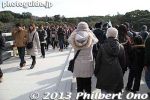
Uji Bridge is also rebuilt every 20 years.
|
|
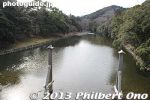
Uji Bridge goes over Isuzu River. 五十鈴川
|
|
|
|

The other end of Uji Bridge also has a torii gate.
|
|
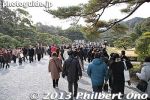
After crossing Uji Bridge, it is a gravel path to the shrine.
|
|
|
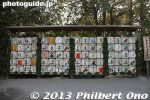
Barrels of sake as offerings.
|
|

Place to dispose of old decorations bought from the shrine.
|
|
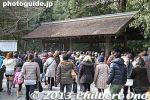
Water fountain where you wash your hands and rinse your mouth for purification. 手水舎
|
|
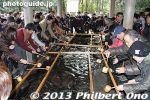
Before praying at the shrine, you're supposed to purify yourself. Wash your hands and rinse your mouth here. Use the ladle to pour water into your hand, then sip the water from your hand. Don't sip the water directly from the ladle. 手水舎
|
|
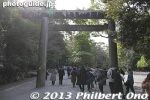
The first torii or Daiichi torii.
|
|
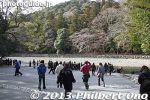
Another place to purify yourself on the banks of Isuzu River at this place called the Mitarashi. 五十鈴川と御手洗場
|
|

Dip your hands here in Isuzu River. Auto maker Isuzu was named after this crystal-clear river. 五十鈴川と御手洗場
|
|
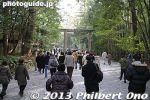
We could easily proceed from Uji Bridge to this Daini (Second) torii. So far so good.
|
|
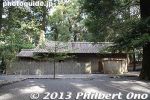
Horse stable.
|
|
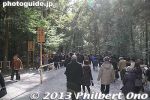
Still walking at a good pace.
|
|
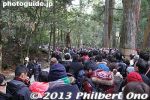
About 300-400 meters to the Naiku shrine, it got congested. It took about an hour to reach the foot of the steps going up to the shrine.
|
|
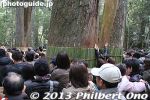
Bamboo strips protect the trees.
|
|
| 1161 files on 5 page(s) |
1 |
 |
 |
|